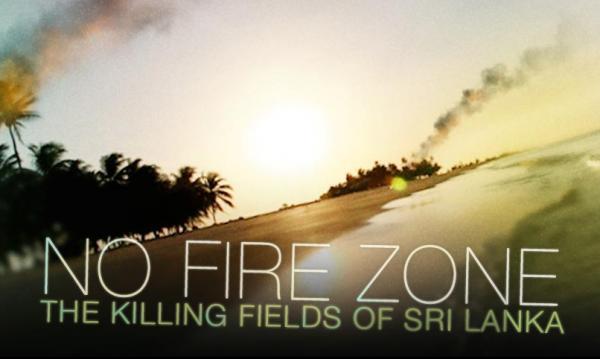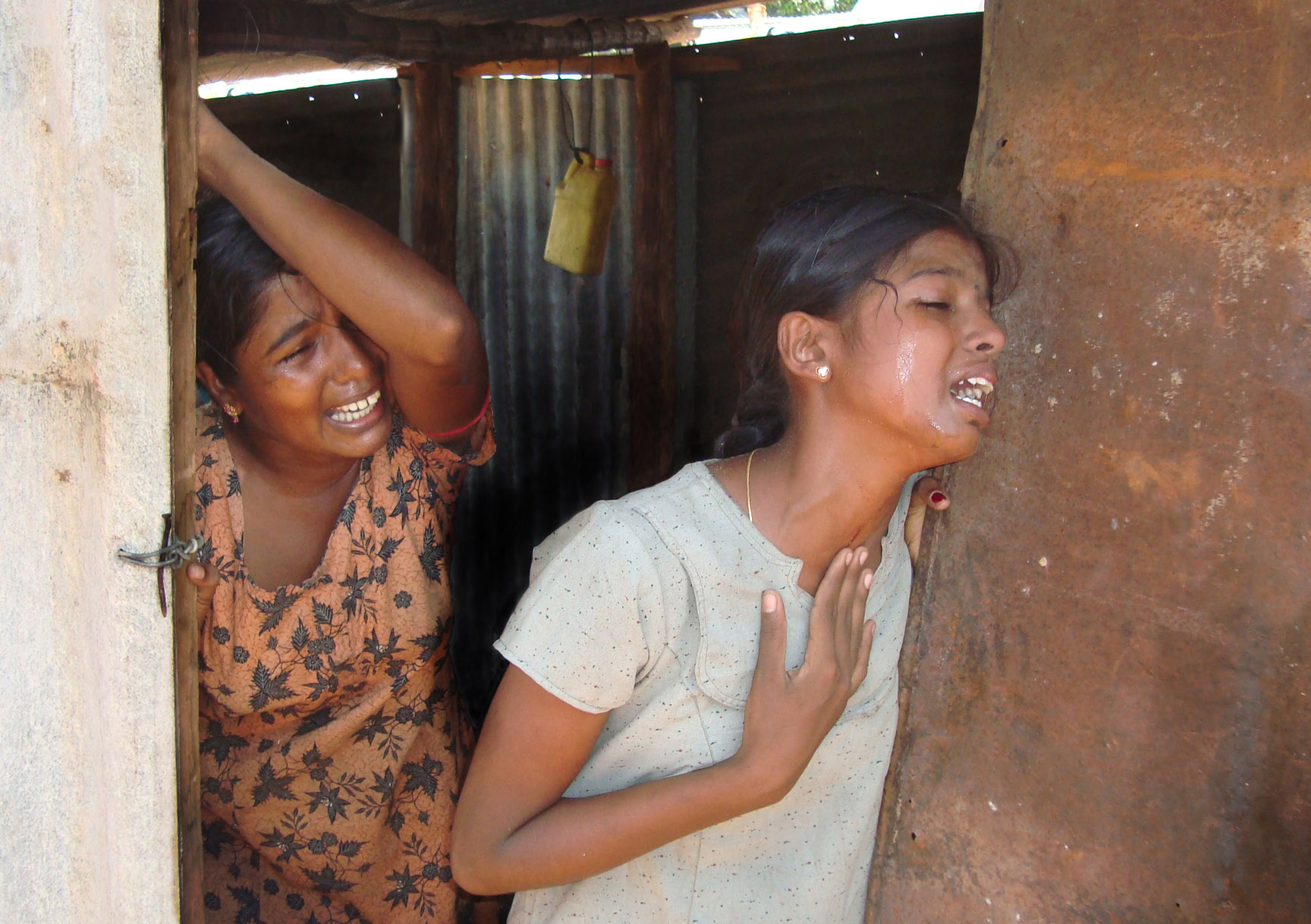
Rarely does a film launch take place at Britain's House of Commons, but there seemed no more appropriate venue for the official release last week of the Sinhala translation of the politically charged No Fire Zone: The Killing Fields of Sri Lanka. The feature film documents the atrocities committed in the final weeks of the Sri Lankan Civil War both by government troops and the Tamil Tigers. This Sinhala translation marks the first time that the people of Sri Lanka will be able to see a film that shows their recent history in stark, unflinching clarity.
The award-winning doc, directed by Callum Macrae was originally released in 2013, and was preceded by two Channel 4 television documentaries on the Sri Lankan Civil War, one of which was the recipient of an AIB Award (watch Channel 4's Sri Lanka's Killing Fields: War Crimes Unpunished).
No Fire Zone has already ignited international political debate with British Prime Minister David Cameron saying, "This documentary raises very serious questions that the Sri Lankan government must answer about what it did to protect innocent civilians. Questions that strengthen the case for an independent investigation."
The House of Commons press conference was attended by Members of Parliament and journalists from around the world. The timing of the announcement was not arbitrary. Later in the evening, President Sirisena of Sri Lanka, on a four-day visit to London, was to have met with the Queen. The President, during his visit, described a new Sri Lanka, set on a course of reform.
For director Callum Macrae, the new Sinhala translation of the film is a challenge to President Sirisena to show the world how genuine his reforms are. In February, the government set up a Presidential Task Force on Reconciliation (PTFR). The Task Force aims to bring about "harmony and effective reconciliation" in Sri Lanka. It remains to be seen if "truth" will also be part of that equation.
No Fire Zone exemplifies how powerful good journalism and good filmmaking can be. The film is an unflinching, meticulously documented look at atrocities committed during the war that have been continuously denied by the government. The Sri Lankan government aggressively blocked the film internationally, frequently with the cooperation of its allies. Both the filmmakers and those trying to screen it have been subjected to banning, arrest, and even death threats.
AIB had the privilege of sitting down with AIB winner and director Callum Macrae to talk about the film, Sri Lanka, and the how journalistic integrity is more important than ever.
What is your background and how did you get started as a filmmaker?
I've been a number of things. In American parlance, I was a "garbage collector" for two years, then a teacher, then became a print journalist, and then a TV journalist and an onscreen reporter. Then as I got older and fatter, I moved behind the camera and became a director.
You have made several films in war zones. Would you say that it's a kind of specialty of your now?
I certainly don't just do war, though I have covered a few conflicts. Quite a few. I've made all sorts of film about all sorts of issues. I've made films about supermarket price wars (watch The Real Price of Cheap Food – Channel 4 Dispatches) and all sorts of things. I feel happiest when I'm making films that are addressing issues of injustice, addressing issues of inequality. As journalists and as filmmakers, we actually have not just an opportunity, but an obligation to try– and this sounds very pretentious –to try and give a voice to the voiceless.
You say, "pretentious," but isn't that something that's essential to good journalism? Journalists tend to be cynics, but do you also have to be an idealist?
I think that as journalists we can tell the truth. I think that as journalists we can tell the stories of people who might not otherwise be heard and that's a great privilege that's a great honour. With this Sri Lanka film, and with the series of Sri Lanka films, somebody said to me 'Are you a campaigner or a journalist? Because you've been effectively pursuing this as a campaign.'
My attitude is: I'm a journalist, first and foremost. I'm a journalist who's got a story and done a lot of work on that story. I also know it to be true. The reactions to the story, particularly from the Sri Lankan government have been to ban it, to say it's lies, to attack it. So I have defended my story, because I know it's true, and I've defended my right to tell that story, even though there's been attempts to ban the film around the world. We've even had death threats. It makes it all the more important the story be told, because people are trying to stop it being told.
If that makes me a campaigner, it makes me a campaigner in defense of my story, in defense of the truth. In that case, I'm happy to be called a campaigner.
Should journalists try to be impartial, or is it important to have a point of view?
There's a bit of a fetish made about the use of the word "impartial." I don't think that is the best word to use, partly because when it is used, it's misused. If you are impartial between the rich and powerful and the poor and vulnerable, then you preserve the status quo. So I think the word "impartial" is all too often used as a kind of device or fig leaf to cover up what is shoddy, complacent and compliant journalism which does not attempt to speak truth to power.
Now there are some things that we do have to be. And I prefer to saying "impartial" that we have to be truthful and accurate and fair. They're all slightly different things, and actually fairness is an extremely important part of that equation. So we're not only being truthful and entirely accurate, which is a fundamental duty, but we are also being fair to all sides – that's not the same as being impartial, at least not in the sense that "impartial" is used. I think those should be our bywords, "truthful," "accurate" and "fair".
We're clearly in a time now when journalists are being bullied and threatened globally. What has been your experience with that?
I think there's change on a number of levels. Certainly in terms of war zones and other situation like that, we used to be seen as impartial people and have a degree of protection. We were seen as, not quite the Red Cross, but with some of the same right to immunity, as it were. That has changed.
I remember very specifically experiencing that change when I went to Iraq in 2003. For about a week we were driving around with "TV" written on the side of our van, thinking that gave us some kind of protection. Over the next two or three weeks, one by one, we took the "TV" signs off our cars and our vans. I took to driving around in battered old taxis, as anonymous-looking as possible.
Things have transformed, and that process of transformation I watched happen over the space of a few weeks. We are seen now as legitimate targets and quite often identified with where we come from and we are no longer seen as impartial. That's one level where things have changed.
But in saying things that are unpopular – "speaking truth to the powerful," as they say – I don't think there has been a change. Journalists have always been attacked when they say things that those in power do not want to hear. So that hasn't changed. And I think that's an essential and fundamental part of our job.
How did you get started making the feature documentary, No Fire Zone?
It's a thing that perplexes the Sri Lankan government who assume that I must have an agenda and assume that I'm being paid by somebody. Interestingly, this is because the Sri Lankan government itself had such a beaten media in the previous regime. Under the previous regime, if you were independent or challenging, you were threatened, disappeared or even killed. If you wanted to survive and be successful and make money, you were absolutely compliant and kowtowed to the government. So there assumption is you can buy journalists, and I think their assumption was that I must have been bought by somebody.
The reality is completely different. It wasn't even an area of my expertise originally. I had made films about war crimes, and I was asked, because of my experience making those kinds of films, to direct a film for TV about what happened at the end of the war in Sri Lanka. So I came into it without any prejudices, without any preconceptions and investigated what happened.
It is without doubt one of the most shocking stories I have ever worked on. I've seen some horrible things in real life. I've seen people die in front of me in wars. But the sheer scale and the deliberate barbarism was so shocking and, frankly, made me angry. That's another thing that journalists should be allowed to be – angry.
Also more importantly, once we started speaking about this, then the victims started coming forward, saying "somebody's listening at last", so we got more and more material. So having been hired to do the first film, I went back to the channel and said, "Look, I think we should make another film." And ITN productions, through the production company, agreed.
What can you do in a feature documentary that you can't do on TV?
There are differences. In television programming you have advert breaks, you have 45 minutes, you have people going out and making a cup of tea or going to the toilet, and you need to construct it around keeping a mass audience interested. When people have decided to come to your feature documentary, they're committed, so you can give more context and you can go into more detail. They're both equally important. I don't think this feature documentary would have happened without the television programmes.
Can a feature reach a different kind of audience? Or is there a different benefit to that kind of distribution?
It's a very different beast. My background is making television, where you're hired to make the film, you're given the budget, you make the film, then it goes out and is seen instantly by a large number of people. A feature you have to win your audience, you have to campaign. The extraordinary thing about a feature is you can spend as much on the publicity and the distribution campaign as you do in making the film.
With the No Fire Zone feature documentary funding was also an issue, because we wanted to make sure when that nobody could argue that anyone who funded it had an agenda. We had to be journalistically independent. So we went to foundations. We went to Channel 4, Pulitzer Foundation, BritDoc, the Bertha Foundation, and a lot of people were very, very generous. These are all institutions that have an agenda of sorts – they all believe in freedom of speech – but they don't have an agenda in terms of Sri Lanka. So we only raised funds from those kinds of organisations.
Once we made the film, then we went to the public. We've had two Kickstarter appeals, both very successful. We've also gone to foundations and various other people and raised the funds to keep the campaign going.
I assume the Sinhalese translation is something you were thinking about all along?
Yes, we've wanted to do a Sinhalese translation for a long time. When we produced the TV documentaries and then the film, the Sri Lankan government under Mahinda Rajapaksa tried to stop anybody seeing it. There were a series of attempts to prevent the film being seen.
They put pressure on foreign governments not to show it. We were at a screening in Malaysia, and it was raided, at the behest of the Sri Lankan government, by the Malaysian authorities. Over 30 police officers and censorship officials came in, and they arrested the organisers, including Lena Hendry from a Malaysian human rights NGO, Pusat KOMAS (Read a letter to the Malaysian Prime Minister from The Law Society in the UK protesting Henry's arrest). And Lena Henry is still facing potentially three years in jail for showing that film.
In India, they refused the film a censorship certificate on the grounds that – and this was in the letter they sent to us, extraordinarily – "it could damage friendly relations with Sri Lanka", an open admission of political censorship. And they banned me from having a visa – they won't let me go to India. We've seen that internationally.
In Sri Lanka itself, we have just seen lies told about the film. They claim that the evidence is faked, which it isn't. They have a problem, which is that every time they claim something is faked, we get more evidence.
So when we showed footage of a twelve-year-old child, Balachandran Prabhakaran, dead, and said that he'd been executed, they said "No, he was killed in a crossfire." We then were able to produce photographs of him, showing that he was alive in captivity for at least two hours before he was taken and executed.
When we said that the Tamil Tiger TV presenter Isaipriya had been executed and sexually assaulted, they said "No, she died in combat. She was fighting." We were subsequently able to get video footage of her being captured alive, and in the new version of the film there are even more stills of her being captured alive. And of course this is a government which said they had a policy of zero civilian casualties and that no civilians had died. We now know that tens of thousands died, possibly 40,000 – possibly even 70,000, according to one UN estimate.
But inside Sri Lanka, the vast majority of the people still believe what they're government told them. They have not seen the film, they haven't been allowed to see the film, and they believe that it is concocted and it's lies. And it isn't.
Now they have a new government, which has said it will lift restrictions on the internet, said that it will allow a free press. We're taking them at their word, and we're making this film available. We hope this film will be seen as widely as possible in Sri Lanka, we hope it won't be banned – we trust it won't be banned. And we're also calling on the Sri Lankan television stations to transmit the entire film.
The new Sinhala translation of No Fire Zone is available at the film's website, NoFireZone.org.






